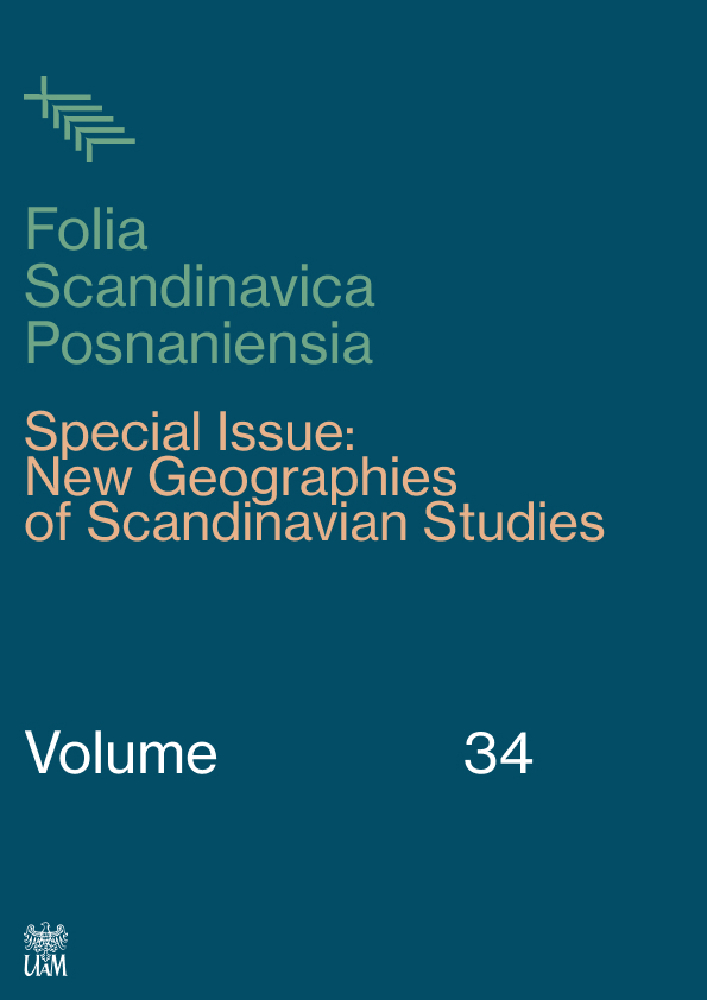Abstract
This article provides an introduction to the Research Network “New Geographies of Scandinavian Studies” while at the same time discussing some of its main concerns and questions: the position of the Nordic countries and the role of Scandinavian Studies in the changing geopolitical landscape of post-Cold War Europe. The collapse of the Eastern bloc in 1989–1991 led to a reconfiguration of the European political map. This situation also entailed new possibilities for international and cross-disciplinary research: A new understanding of Nordic and Baltic studies was institutionalized and new regional concepts were developed as alternatives to Cold War geopolitics. The network “New Geographies of Scandinavian Studies” is rooted in this ongoing reorientation of the field. The article discusses some of the potentials and challenges of this new agenda of Scandinavian Studies in the context of the new geopolitical confrontation between Russia and the West after Russia’s military attack on Ukraine in February 2022.
References
Andersen, P. T. (2006). Identitetens geografi: Steder i litteraturen fra Hamsun til Naipaul. Oslo: Universitetsforlaget.
Andersen, P. T. (2013). Til stede. Oslo: Vigmostad & Bjørke. DOI: https://doi.org/10.17992/lbl.2013.03.487
Ash, T. G (1989). The uses of adversity: Essays on the fate of Central Europe. New York: Random House.
Ash, T. G., Krastev, I. & Leonard, M. (2023). United West, divided from the rest: Global public opinion one year into Russia’s war on Ukraine. European Council on Foreign Relations. ecfr.eu. Retrieved from https://ecfr.eu/publication/united-west-divided-from-the-rest-global-public-opinion-one-year-into-russias-war-on-ukraine/ (accessed 14 September 2023).
Beller, M. & Leerssen, J. (eds.) (2007). Imagology: The cultural construction and literary representation of national characters. Amsterdam: Rodopi. DOI: https://doi.org/10.1163/9789004358133
Bredsdorff, E. (1986). The history of IASS. Göteborg: Göteborgs Universitet.
Bredsdorff, E. & Garton, J. (2006). The history of the International Association of Scandinavian Studies 1956–2006. Norwich: Norvik Press.
Bredsdorff, E. et al. (2003). International Association for Scandinavian Studies (IASS). Diogenes 50(2), 112–115. DOI: https://doi.org/10.1177/039219210305000209
Browning C. S. (2007). Branding Nordicity: Models, identity and the decline of exceptionalism. Cooperation and Conflict 42(1), 47–51. DOI: https://doi.org/10.1177/0010836707073475
Cresswell, T. (2014). Place: An introduction. 2nd ed. Hoboken: Wiley.
Czapliński, P. (2020). Literature and geography. Porównania 27(2), 143–166. DOI: https://doi.org/10.14746/por.2020.2.8
Dahl, I. A. et al. (2014). Der Norden in der neuen Mitte: Zur Gründung des Nordeuropa-Instituts. Berlin: Nordeuropa-Institut, Humboldt-Universität zu Berlin.
Einhorn, E., Harbison, S. & Huss, M. (eds). (2022). Migration and multiculturalism in Scandinavia. Madison: University of Wisconsin Press. DOI: https://doi.org/10.2307/j.ctv27h1p5g
Fukuyama, F. (1992). The end of history and the last man. New York: Free Press.
Henningsen, B. & Stråth, B. (eds.) (1996). Deutschland, Schweden und die Ostsee-Region. Baden-Baden: Nomos.
Hilson, M. (2008). The Nordic model. Scandinavia since 1945. London: Reaktion Books.
Jelsbak, T. (2023). Skandinaviske studier og geopolitik: IASS og den kolde krig. Scandinavistica Vilnensis. Temanr.: Memory and Remembrance in Scandinavian Culture 17(1), 7–26. DOI: https://doi.org/10.15388/ScandinavisticaVilnensis.2023.2
Leersen, J. (2022). The camp and the home: Europe as myth and metaphor. In J. Barkhoff & J. Leerssen (eds.), National stereotyping, identity politics, European crises (pp. 125–141). Leiden: Brill. DOI: https://doi.org/10.1163/9789004436107_008
Mai, A.-M. & Ringgaard, D. (eds.) (2010). Sted. Aarhus: Aarhus Universitetsforlag.
Malmio, K. & Kurikka, K. (eds.) (2019). Contemporary Nordic literature and spatiality. Cham: Palgrave Macmillan. DOI: https://doi.org/10.1007/978-3-030-23353-2
Mazierska, E. et al. (eds.) (2014). Postcolonial approaches to Eastern European cinema: Portraying neighbours on-screen. London and New York: I.B. Tauris. DOI: https://doi.org/10.5040/9780755603466
Ringgaard, D. & Dubois, T. (2017). The framework: Spatial nodes. In S. P. Sondrup, M. B. Sandberg, DOI: https://doi.org/10.1075/chlel.xxxi.02rin
T. A. DuBois & D. Ringgaard (eds.), Nordic literature: A comparative history, volume I: Spatial nodes (pp. 19–29). Amsterdam, Philadelphia: John Benjamins.
Šukaitytė, R. (2015). Desires and memories of a small man: The poetic documentaries of Lithuanian filmmaker Audrius Stonys. In J. Blankenship & T. Nagl (eds.), European visions. Small cinemas in transition (pp. 317–333). Bielefeld: transcript. DOI: https://doi.org/10.1515/9783839418185-020
Wolff, L. (1994). Inventing Eastern Europe. The map of civilization on the mind of the Enlightenment. Redwood City, CA: Stanford University Press.


